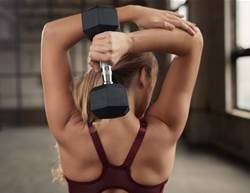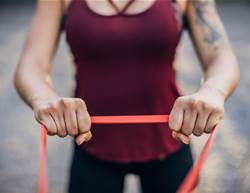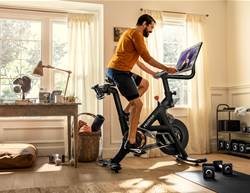We all know that exercise is a healthy-life necessity. A regular fitness regime reduces our risk of major illnesses including cancers and strokes, and it’s proven to help us live longer.
Yet, for many years, the motivation for exercising for a lot of people was based around looking “good”. We worked out for weight loss, striving for the “skinny look” popularised by catwalks and celebrities. For decades, women’s exercise focused mainly on aerobics and cardio, with punishing workouts and diet trends promising weight-loss for optimum attractiveness.
Strong not skinny
As a result, most of us have grown up with the deeply ingrained belief that thin is in. But over the past decade, the tide has been turning. The phrase “strong not skinny” began gaining traction on social media in 2013; part of a broader movement that encouraged women to focus on health instead of size.
Previously thought to be the domain of buff men, strength training started surging in popularity among women, with many realising that it’s all about being fit and powerful rather than creating a bodybuilder look. Now, the hashtag #strongnotskinny has more than 9.4m Instagram posts.
Confirming this shift, Google searches for “weight-loss tips” have been in decline since 2017, while searches about how to build muscle have been increasing.
Of course, that’s not to say appearance doesn’t matter, but more that the balance appears to be tipping away from how exercise makes us look, towards how it makes us feel; the power and vitality it can provide.
“Unlearning diet culture is hard, but we are going in the right direction,” says fitness coach and Danni Tabor. “Our clients’ priority is to get strong, so they feel capable and confident.”
Worth the weight
There’s a reason why strength training isn’t an exercise fad: building strength and muscle has a stream of benefits. “This type of training supports heart health, bone health, brain health, pelvic health, mental health… it positively affects every single system in our bodies,” says specialist women’s physiotherapist Fiona Mitchell.
A 2022 study in The British Journal of Sports Medicine found that people who did muscle strengthening exercises for just 30-60 minutes per week had a 10-20% lower risk of dying from all causes compared with people who did none.
Strength training as we get older
But if this all feels like a leap into the unknown, you’re not alone. “Women like me, in their 50s, grew up with step aerobics, so they might feel intimidated by strength training or not understand the need for it,” says Mitchell. But it’s even more valuable for women in midlife. As we get older, we begin losing muscle mass and bone density – but when we build strength, we’re building it everywhere: stronger muscles are better at supporting bones, tendons and joints.
“This includes the pelvic floor, which is a muscle in itself,” says Mitchell. “Resistance training can therefore ward off pelvic health issues that are common for midlife women, such as stress incontinence.”
The experts agree that strength training is a fantastic tool to help us stay independent and “functional” (meaning that we can better do what daily life demands of us) as we age.
“Rather than focusing on lifting heavier weights for the sake of it, I tell my clients to consider lifting their 10kg hand luggage into an overhead locker on an aeroplane in their 80s,” says Mitchell.
Having strength enables us to live the lives we want, without needing to depend on anyone. Plus, focusing on strength has brilliant preventative effects. “Only half of people return to their pre-injury mobility after a hip fracture, so it’s about stopping slips, trips and falls from happening in the first place,” advises Mitchell.
These accidents also reduce life expectancy, but research shows that strength training helps with balance, posture and mobility.
Nutrition also has a role to play in building our strength and muscle, says Tabor. “Protein is a building block for muscles, but the body doesn’t store it, so we have to make a deliberate effort to eat it by adding protein to each meal.”
Ultimately, she says, this mindset is about adding – adding muscle, adding strength, adding more on to your plate – rather than taking away. This may feel counterintuitive if you grew up on diet culture, which focuses on eating less and taking up less space, but it can be more empowering.
Happily, studies show that if you strength train, your body image will improve, too.
So, what are the best ways to build strength?
Resistance work (any version of exercising your muscles using an opposing force) can be done on a mat in your living room; it might incorporate bodyweight exercises, moving on to using tins of food, dumbbells, or even lifting heavier weights at the gym.
The key, Danni Tabor explains, is to tire out your muscles. “Create resistance, either with your own body or with equipment, and repeat an exercise to the point where you can’t do another rep,” she says.
“With aerobics and cardio, we learned that more reps are better, but if the aim is building muscle, it’s more beneficial to do one push-up and know you can’t do any more than do 10 fast exercises with no resistance and finish knowing you could have done 20.”
When you can do one push-up, add another, then another, and you’ll soon notice your strength grow. The best news? It’s never too late to start.
For the best health benefits, you should maintain your cardio and add strength training alongside. “It’s a case of doing both, not either or,” advises menopause doctor Dr Shahzadi Harper.
See your GP before starting any new exercise.
A practical guide to strength training
You can start training at home using just your body weight (without equipment). Tabor suggests beginning with these low-impact exercises. But don’t stay at the same level for too long – once you can do them easily, add more reps, hold for longer or use a dumbbell to continue building strength and muscle.

3 sets of 10 split-leg squats
Stand with feet under hips, then take one leg behind you, so the front leg is at a roughly 90-degree angle. Keep back heel up and front foot flat on the ground. Now lower the back knee down to the floor, then push through the front flat foot to lift the knee again. Repeat 10 times on the same leg, then swap.

3 x 30-second planks
Lie on the floor, with palms placed directly under shoulders. Press up firmly to come on to hands and toes, pushing shoulder blades apart, squeezing your bottom and tensing your core. Hold for 30 seconds. Variation: forearm plank with elbows under shoulders and forearms flat on the floor.

3 sets of 5 pause squats
Start with feet slightly wider than hips and feet facing forward or turned out. Lead with your hips, dropping into a squat as if going to sit down, keeping your chest as upright as possible. When thighs are parallel to the floor or deeper, pause for three seconds, then push the ground away with a focus on the heels.

2 sets of 15 glute bridges
Lie on your back with arms by your sides. Bring your knees up with feet flat on the ground. Engage core and glutes and lift your bottom in the air, keeping your pelvis tilted up to the ceiling, not down to the ground. Lower back down.

3 sets of 5 kneeling push-ups
Lie on your front with hands under chest. Push up, leaving knees where they are. Shoulders, hips and knees should be in a diagonal line. Keep feet in the air. Lower down with elbows at 45 degrees, not dropping hips. Push back up.
Proper technique and good form are essential to avoid injury when strength training, so stop if you feel any pain.









